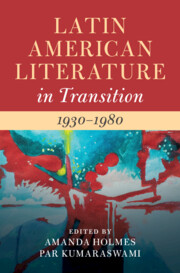Book contents
- Latin American Literature in Transition 1930–1980
- Latin American Literature in Transition
- Latin American Literature in Transition 1930–1980
- Copyright page
- Contents
- Contributors
- Introduction
- Part I War, Revolution, Dictatorship
- Part II Metropolis and Ruins
- Part III Solidarity
- Chapter 9 “Dar Testimonio” as a Lens for Rethinking the Mexican Literary Canon
- Chapter 10 Landscapes of Heterogeneity in a Mid-Twentieth-Century Quechua Poem
- Chapter 11 Beyond the Nation Frame
- Chapter 12 Femininity in Flux
- Chapter 13 The Representation of Afro-Cuban Orality by Fernando Ortiz, Lydia Cabrera, and Nicolás Guillén
- Part IV Aesthetics and Innovation
- Index
- References
Chapter 10 - Landscapes of Heterogeneity in a Mid-Twentieth-Century Quechua Poem
from Part III - Solidarity
Published online by Cambridge University Press: 24 January 2023
- Latin American Literature in Transition 1930–1980
- Latin American Literature in Transition
- Latin American Literature in Transition 1930–1980
- Copyright page
- Contents
- Contributors
- Introduction
- Part I War, Revolution, Dictatorship
- Part II Metropolis and Ruins
- Part III Solidarity
- Chapter 9 “Dar Testimonio” as a Lens for Rethinking the Mexican Literary Canon
- Chapter 10 Landscapes of Heterogeneity in a Mid-Twentieth-Century Quechua Poem
- Chapter 11 Beyond the Nation Frame
- Chapter 12 Femininity in Flux
- Chapter 13 The Representation of Afro-Cuban Orality by Fernando Ortiz, Lydia Cabrera, and Nicolás Guillén
- Part IV Aesthetics and Innovation
- Index
- References
Summary
This chapter discusses a bilingual poem in Quechua and Spanish by the twentieth-century Peruvian writer, Teodoro Meneses Morales (1915-87). It argues that the poem evinces a loss of solidarity between humanity and the wider cosmos and that this loss is the result of social, cultural, and environmental transitions occurring at the time. By synthesizing Cornejo Polar’s concept of heterogeneity with Westphal’s geocritical approach, the chapter develops a theoretical framework that accounts for how transitions in mid-twentieth-century Peruvian society disrupt normal patterns of relating to the natural environment as reflected in the poem. As humanity becomes ever more fragmented, pulled in opposing directions between traditional Andean and Western ways of relating to the land, so the land itself ceases to be the stable environment that it was before. In Meneses Morales’ poem, the emblem of such transformations is a drought. While far from unprecedented in the Andes, in a context of heterogeneity this natural disaster becomes symbolic of a more fundamental dislocation between the human inhabitant and the wider landscape of which humans form a part.
Keywords
- Type
- Chapter
- Information
- Latin American Literature in Transition 1930–1980 , pp. 164 - 181Publisher: Cambridge University PressPrint publication year: 2022

